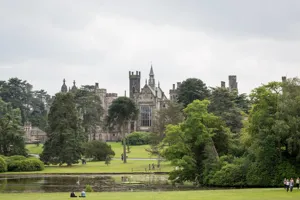Alton Towers Heritage

The Beginnings of The Towers
Founded on the site of an Iron Age camp, there were actually many different buildings before the existing Towers, but from 1412 until 1924 they all belonged to the same family - the Talbots (Earls of Shrewsbury).
The Beginnings of Alton Towers as an Attraction
The grounds at Alton Towers were first opened to the public by the 18th Earl in 1860 when the total income was £116.17s 5d (£116.87p!). By 1890 Alton Towers was attracting crowds of 30,000 to watch acrobats, lion tamers, elephants, bands and fireworks, as well as the gardens.
In the early 1900s the 20th Earl, who had interests in the Talbot Motor Car Company which he had founded, began to spend more and more time at his Ingestre Estate. Lady Shrewsbury lived alone at the Towers until 1923 after her husband's death in 1921. Although the bulk of the estate had already been sold in 1918, in 1924 the remaining lands and Alton Towers itself were sold to a group of local businessmen. So, after some 700 years the Towers and the Estate passed out of the hands of the Earls of Shrewsbury.


What happened next?
The house and gardens remained open until the outbreak of War when it was requisitioned as an Officer Cadet Training Camp. The Ministry of Defence retained possession of the buildings until the mid 1950's when, after some legal argument over it’s condition, it was finally returned to the then owners, Alton Towers Ltd, who continued to run it as a successful business.
Although the Park had become a well known tourist attraction throughout the '60s and '70s it was not until 1980 that it became known as a Theme Park, with the introduction of the then revolutionary Corkscrew rollercoaster.
Did You Know?
- During Scarefest The Towers are home to 3 of our terrifying scare mazes!

The Legend of The Towers
If you’re a fan of the history of The Towers, then there are plenty of ways to learn about their mysterious history.
Have you explored Hex: The Legend of the Towers? Enter the iconic building at the heart of the theme park and fall deep into the local legend of the chained oak.
Current Restoration Projects
Alton Towers Resort and its Heritage Committee are passionate about the continual restoration of both the Grade II★ listed Towers (a key building of the Georgian and Victorian Gothic Revival) and the Grade I listed Gardens.

The Banqueting Hall Window
Expensive inheritance battles, as well as a changing financial and social climate led to much of the estate’s land and house contents being sold in the 1900s (a fate that befell many stately homes). In its heyday (1850’s) Alton Towers was one of the largest privately owned houses in Europe and when the 16th Earl, John Talbot was planning to alter the dining room, Augustus Welby Pugin persuaded him not to compromise on the design, including the installation of a hugely impressive bay window.

The iconic banqueting hall bay window is Pugin (Victorian Gothic Revival) in style, and measures roughly 10m tall by 6m wide - the largest of its kind to be designed by Pugin for a private house!
The 27 stained glass panes are arranged in three tiers, the top two tiers celebrating the coats of arms of the Earls of Shrewsbury and the families they were associated with (we’ve highlighted the names of the coats of arms to make them easier to see; please note spellings of some of the names differ from the way we spell them today). Historically, it is the most important window of its kind outside the Palace of Westminster!

Restoration Process
The window was last removed in 2010 for refurbishment, however, at this time, the original manufacturers of the stained glass (Hardman’s of Birmingham) went out of business. Fortunately, two of Hardman’s former craftsmen were found and commissioned to restore it. To give you an understanding of the craftmanship involved, here’s a before and after of the one segment of the window:

After several years of painstaking work, the restored window will now return to its home, 170 years after it was originally installed.